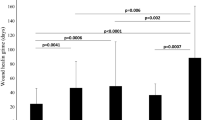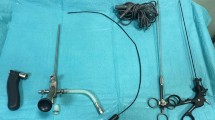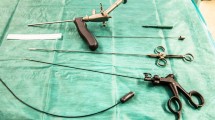Abstract
Background
Pilonidal disease (PD) is a common condition of the sacrococcygeal region leading to inflammation and abscess formation. PD is a topic of renewed interest due to the lack of satisfactory management options. Minimally invasive techniques have recently been investigated, with promising results in adult and pediatric populations. Our technique, the “EPIC procedure,” Endoscopic-assisted Pilonidal Irrigation and Cleaning, involves removal of hair under direct visualization using a small endoscope while flushing saline through the cavity via an angiocatheter. We aim to show that the EPIC procedure is a safe and effective operation for the treatment of pilonidal disease in the pediatric population.
Materials and methods
We performed a retrospective chart review including 20 consecutive patients. All had a primary sacrococcygeal pilonidal sinus; all underwent the EPIC procedure. Post-operative care instructions included daily bathing and weekly depilatory application. We evaluated gender, age, weight, disease severity, operative duration, recurrence of PD, and other complications.
Results
In the 20 patients studied, 22 EPIC procedures were performed. The median follow-up duration was 27.95 (range 0.63–45.27) months. The mean operative duration was 28.8 (SD 10.2) min. There was a 15% recurrence rate (95% CI 0.00%, 30.65%).
Conclusions
The EPIC procedure is an endoscopic-assisted operation that simplifies previously published techniques in pursuit of reduced operative complexity, cost, and time, with comparable recurrence and complication rates. All three recurrences occurred in patients that did not follow instructions for post-operative depilatory care. Two of these patients underwent repeat EPIC procedure and had no further complications. The third was lost to follow-up. The EPIC procedure provides a simple, effective, and minimally invasive approach to the treatment of pilonidal disease.
Similar content being viewed by others
References
Khanna A, Rombeau JL (2011) Pilonidal disease. Clin Colon Rectal Surg 24:46–53
de Parades V, Bouchard D, Janier M, Berger A (2013) Pilonidal sinus disease. J Visc Surg 150:237–247
Chintapatla S, Safarani N, Kumar S, Haboubi N (2003) Sacrococcygeal pilonidal sinus: historical review, pathological insight and surgical options. Tech Coloproctol 7:3–8
Søndenaa K, Andersen E, Nesvik I, Søreide JA (1995) Patient characteristics and symptoms in chronic pilonidal sinus disease. Int J Colorectal Dis 10:39–42. https://doi.org/10.1007/BF00337585
Lord PH, Millar DM (1965) Pilonidal sinus: a simple treatment. Br J Surg 52:298–300. https://doi.org/10.1002/bjs.1800520413
Azab ASG, Kamal MS, Saad RA, Abou Al Atta KA, Ali NA (1984) Radical cure of pilonidal sinus by a transposition rhomboid flap. Br J Surg 71:154–155. https://doi.org/10.1002/bjs.1800710227
Bascom JU (1987) Repeat pilonidal operations. Am J Surg 154:118–122. https://doi.org/10.1016/0002-9610(87)90300-X
Hull TL, Wu J (2002) Pilonidal disease. Surg Clin North Am 82:1169–1185
Isik A, Idiz O, Firat D (2016) Novel approaches in pilonidal sinus treatment. Prague Med Rep 117:145–152. https://doi.org/10.14712/23362936.2016.15
Meinero P, Mori L (2011) Video-assisted anal fistula treatment (VAAFT): a novel sphincter-saving procedure for treating complex anal fistulas. Tech Coloproctol 15:417–422. https://doi.org/10.1007/s10151-011-0769-2
Jain Y, Javed MA, Singh S, Rout S, Joshi H, Rajaganeshan R (2017) Endoscopic pilonidal abscess treatment: a novel approach for the treatment of pilonidal abscess. Ann R Coll Surg Engl 99:134–136. https://doi.org/10.1308/rcsann.2016.0260
Meinero P, Stazi A, Carbone A, Fasolini F, Regusci L, La Torre M (2016) Endoscopic pilonidal sinus treatment: a prospective multicentre trial. Color Dis 18:O164–O170. https://doi.org/10.1111/codi.13322
Meinero P, Mori L, Gasloli G (2014) Endoscopic pilonidal sinus treatment (E.P.Si.T.). Tech Coloproctol 18:389–392. https://doi.org/10.1007/s10151-013-1016-9
Esposito C, Izzo S, Turrà F, Cerulo M, Severino G, Settimi A, Iannazzone M, Masieri L, Cortese G, Escolino M (2018) Pediatric endoscopic pilonidal sinus treatment, a revolutionary technique to adopt in children with pilonidal sinus fistulas: our preliminary experience. J Laparoendosc Adv Surg Tech 28:359–363. https://doi.org/10.1089/lap.2017.0246
Rao MM, Zawislak W, Kennedy R, Gilliland R (2010) A prospective randomised study comparing two treatment modalities for chronic pilonidal sinus with a 5-year follow-up. Int J Colorectal Dis 25:395–400. https://doi.org/10.1007/s00384-009-0804-1
Oncel M, Kurt N, Kement M, Colak E, Eser M, Uzun H (2002) Excision and marsupialization versus sinus excision for the treatment of limited chronic pilonidal disease: a prospective, randomized trial. Tech Coloproctol 6:165–169. https://doi.org/10.1007/s101510200037
Mohamed HA, Kadry I, Adly S (2005) Comparison between three therapeutic modalities for non-complicated pilonidal sinus disease. Surgeon 3:73–77. https://doi.org/10.1016/S1479-666X(05)80065-4
McCallum IJD, King PM, Bruce J (2008) Healing by primary closure versus open healing after surgery for pilonidal sinus: systematic review and meta-analysis. BMJ 336:868–871. https://doi.org/10.1136/bmj.39517.808160.BE
Abramson DJ (1960) A simple marsupialization technic for treatment of pilonidal sinus: long-term follow up. Ann Surg 151:261–267. https://doi.org/10.1097/00000658-196002000-00017
Solla JA, Rothenberger DA (1990) Chronic pilonidal disease—an assessment of 150 cases. Dis Colon Rectum 33:758–761. https://doi.org/10.1007/BF02052321
Monro RS, McDermott FT (1965) The elimination of causal factors in pilonidal sinus: treated by Z-plasty. Br J Surg 52:177–181. https://doi.org/10.1002/bjs.1800520306
Dýlek ON, Bekereciodlu M (1998) Role of simple V-Y advancement flap in the treatment of complicated pilonidal sinus. Eur J Surg 164:961–964. https://doi.org/10.1080/110241598750005147
Özcan B, İlkgül Ö (2019) Contralateral Limberg flap reconstruction for pilonidal disease recurrence. Asian J Surg 42:787–791
Dudink R, Veldkamp J, Nienhuijs S, Heemskerk J (2011) Secondary healing versus midline closure and modified bascom natal cleft lift for pilonidal sinus disease. Scand J Surg 100:110–113. https://doi.org/10.1177/145749691110000208
Fazeli MS, Adel MG, Lebaschi AH (2006) Comparison of outcomes in Z-plasty and delayed healing by secondary intention of the wound after excision of the sacral pilonidal sinus: results of a randomized, clinical trial. Dis Colon Rectum 49:1831–1836. https://doi.org/10.1007/s10350-006-0726-8
Bascom J (1980) Pilonidal disease: origin from follicles of hairs and results of follicle removal as treatment. Surgery 87:567–572. https://doi.org/10.1016/s0022-3468(81)80139-x
Bascom J (1983) Pilonidal disease: long-term results of follicle removal. Dis Colon Rectum 26:800–807. https://doi.org/10.1007/BF02554755
Nordon IM, Senapati A, Cripps NPJ (2009) A prospective randomized controlled trial of simple Bascom’s technique versus Bascom’s cleft closure for the treatment of chronic pilonidal disease. Am J Surg 197:189–192. https://doi.org/10.1016/j.amjsurg.2008.01.020
Bascom J, Bascom T (2002) Failed pilonidal surgery: new paradigm and new operation leading to cures. Arch Surg 137:1146–1150. https://doi.org/10.1001/archsurg.137.10.1146
Ortega PM, Baixauli J, Arredondo J, Bellver M, Sánchez-Justicia C, Ocaña S, Hernández-Lizoain JL (2014) Is the cleft lift procedure for non-acute sacrococcygeal pilonidal disease a definitive treatment? Long-term outcomes in 74 patients. Surg Today 44:2318–2323. https://doi.org/10.1007/s00595-014-0923-3
Meinero P, La Torre M, Lisi G, Stazi A, Carbone A, Regusci L, Fasolini F (2019) Endoscopic pilonidal sinus treatment (EPSiT) in recurrent pilonidal disease: a prospective international multicenter study. Int J Colorectal Dis 34:741–746. https://doi.org/10.1007/s00384-019-03256-8
Emile SH, Elfeki H, Shalaby M, Sakr A, Giaccaglia V, Sileri P, Wexner SD (2018) Endoscopic pilonidal sinus treatment: a systematic review and meta-analysis. Surg Endosc 32:3754–3762
Sequeira JB, Coelho A, Marinho AS, Bonet B, Carvalho F, Moreira-Pinto J (2018) Endoscopic pilonidal sinus treatment versus total excision with primary closure for sacrococcygeal pilonidal sinus disease in the pediatric population. J Pediatr Surg 53:2003–2007. https://doi.org/10.1016/j.jpedsurg.2018.02.094
Esposito C, Turrà F, Cerulo M, Del Conte F, Esposito G, Prato AP, Escolino M (2020) Technical standardization of MIS management of children with pilonidal sinus disease using pediatric endoscopic pilonidal sinus treatment (PEPSiT) and laser epilation. J Pediatr Surg 55:761–766. https://doi.org/10.1016/j.jpedsurg.2019.04.031
Acknowledgements
The authors wish to thank Cuyler Huffman of Western Michigan University Homer Stryker M.D. School of Medicine, Division of Epidemiology and Biostatistics for assistance with statistical analysis.
Author information
Authors and Affiliations
Corresponding author
Ethics declarations
Disclosures
Michael Leinwand is on the advisory board of Virtual Ports Laparoscopic Systems. Jacob Baxter and Jairo Espinosa have no conflicts of interest or financial ties to disclose.
Additional information
Publisher's Note
Springer Nature remains neutral with regard to jurisdictional claims in published maps and institutional affiliations.
Rights and permissions
About this article
Cite this article
Baxter, J., Espinosa, J.A. & Leinwand, M.J. The EPIC procedure (Endoscopic-assisted Pilonidal Irrigation and Cleaning): a simple and effective treatment for pilonidal disease. Surg Endosc 36, 1380–1384 (2022). https://doi.org/10.1007/s00464-021-08422-0
Received:
Accepted:
Published:
Issue Date:
DOI: https://doi.org/10.1007/s00464-021-08422-0




